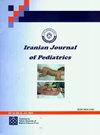Analysis of Risk Factors for the Recurrence of Helicobacter Pylori Infection in Baoding Children Aged 4 - 16 Years
IF 0.4
4区 医学
Q4 PEDIATRICS
引用次数: 0
Abstract
Background: Helicobacter pylori (H. pylori) infection affects over 50% of the world's population and is the primary cause of duodenal and gastric ulcers, as well as gastric cancer. Objectives: To investigate the risk factors for recurrence following successful eradication of H. pylori infection in children aged 4 - 16 years in the Baoding area. Methods: The study included 328 children diagnosed with H. pylori infection at our hospital from January 2021 to June 2022, who had successfully undergone eradication treatment. A questionnaire covering personal history, family history, health status, and family socioeconomic status was administered to the children, coupled with a 1-year follow-up. Recurrence within this period was monitored, along with an analysis of the risk factors for recurrence post-eradication. Results: Out of 328 children with H. pylori infection, 295 (89.9%) were successfully followed up. Among these, 55 (18.6%) tested positive on the 13C-urea breath test and were considered to have recurrent infection (recurrence group), while 240 (81.4%) tested negative and were considered to have no recurrence (non-recurrence group). Univariate chi-square analysis of the questionnaire results indicated that age (P < 0.05), number of eradication treatments (P < 0.05), mother's education level (P < 0.05), place of residence (P < 0.05), family income (P < 0.05), family history of H. pylori infection (P < 0.05), separate meals (P < 0.05), and lunch location (P < 0.05) significantly influenced H. pylori recurrence. Multivariate analysis, which included factors showing significant differences in univariate analysis, was performed using a logistic regression model. This analysis identified multiple treatments (> 2 eradication attempts), residing in rural areas, and low family income as combined risk factors for H. pylori recurrence in children. Conversely, being older than 10 years, eating separate meals, and higher maternal education level emerged as protective factors against recurrence. Conclusions: There is a relatively high rate of H. pylori recurrence among children aged 4 - 16 years in this region, which may be linked to age, number of eradication treatments, dietary and hygiene habits, educational levels of family members, and economic status.保定市 4-16 岁儿童幽门螺杆菌感染复发的风险因素分析
背景:幽门螺杆菌(H. pylori)感染影响着全球 50%以上的人口,是十二指肠溃疡和胃溃疡以及胃癌的主要病因。研究目的调查保定地区 4-16 岁儿童成功根除幽门螺杆菌感染后复发的风险因素。研究方法研究纳入 2021 年 1 月至 2022 年 6 月期间在我院确诊为幽门螺杆菌感染并成功接受根除治疗的 328 名儿童。对这些儿童进行了包括个人病史、家族病史、健康状况和家庭社会经济状况在内的问卷调查,并进行了为期 1 年的随访。监测期间的复发情况,并分析根除治疗后复发的风险因素。结果:在 328 名幽门螺杆菌感染儿童中,有 295 名(89.9%)成功接受了随访。其中,55人(18.6%)在13C-尿素呼气试验中呈阳性,被认为是感染复发(复发组),240人(81.4%)呈阴性,被认为是未复发(未复发组)。对问卷结果进行的单变量卡方分析表明,年龄(P<0.05)、根除治疗次数(P<0.05)、母亲受教育程度(P<0.05)、居住地(P<0.05)、家庭收入(P<0.05)、家族幽门螺杆菌感染史(P<0.05)、分餐制(P<0.05)和午餐地点(P<0.05)对幽门螺杆菌复发有显著影响。使用逻辑回归模型进行了多变量分析,其中包括在单变量分析中显示出显著差异的因素。该分析发现,多次治疗(> 2 次根除尝试)、居住在农村地区和家庭收入低是儿童幽门螺杆菌复发的综合风险因素。相反,年龄大于 10 岁、三餐分开、母亲教育程度较高则是幽门螺杆菌复发的保护因素。结论该地区 4-16 岁儿童幽门螺杆菌复发率相对较高,这可能与年龄、根除治疗次数、饮食和卫生习惯、家庭成员受教育程度以及经济状况有关。
本文章由计算机程序翻译,如有差异,请以英文原文为准。
求助全文
约1分钟内获得全文
求助全文
来源期刊
CiteScore
0.90
自引率
20.00%
发文量
75
审稿时长
6-12 weeks
期刊介绍:
Iranian Journal of Pediatrics (Iran J Pediatr) is a peer-reviewed medical publication. The purpose of Iran J Pediatr is to increase knowledge, stimulate research in all fields of Pediatrics, and promote better management of pediatric patients. To achieve the goals, the journal publishes basic, biomedical, and clinical investigations on prevalent diseases relevant to pediatrics. The acceptance criteria for all papers are the quality and originality of the research and their significance to our readership. Except where otherwise stated, manuscripts are peer-reviewed by minimum three anonymous reviewers. The Editorial Board reserves the right to refuse any material for publication and advises that authors should retain copies of submitted manuscripts and correspondence as the material cannot be returned. Final acceptance or rejection rests with the Editors.

 求助内容:
求助内容: 应助结果提醒方式:
应助结果提醒方式:


